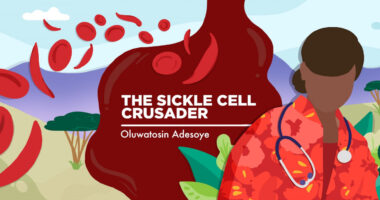Bluebird Bio Presents Data from LentiGlobin Gene Therapy Trial

Bluebird Bio’s investigational gene therapy LentiGlobin safely prevents serious vaso-occlusive crises and acute chest syndrome in adolescents and adults with severe sickle cell disease (SCD), according to recent data from a Phase 1/2 clinical trial.
The findings, “Outcomes in patients treated with LentiGlobin for sickle cell disease (SCD) gene therapy: updated results from the Phase 1/2 HGB-206 group C study,” were recently presented at the virtual 25th European Hematology Association (EHA) Annual Congress.
“The promising results of this study, which show patients have an almost complete elimination of VOCs [vaso-occlusive crises] and ACS [acute chest syndrome], suggest LentiGlobin … has real potential to provide a significant impact for people living with sickle cell disease,” Julie Kanter, MD, said in a press release. Kanter is from The University of Alabama at Birmingham and presented the data.
Based on the data and discussions with the U.S. Food and Drug Administration (FDA), Bluebird expects to submit a biologics license application seeking LentiGlobin’s approval for treating SCD in the second half of 2021.
“We are pleased to have reached a general agreement with the FDA on the clinical data required to support a submission for LentiGlobin for SCD and we plan to seek an accelerated approval,” said David Davidson, MD, Bluebird’s chief medical officer.
A U.S.-based, Phase 3 clinical trial of LentiGlobin (NCT04293185), called HGB-210, is recruiting approximately 35 children and adults with SCD. More information on contacts and locations is available here.
LentiGlobin is a gene therapy designed to increase the levels of hemoglobin, the protein in red blood cells that carries oxygen and is defective in people with SCD due to mutations in the HBB gene.
The single-dose therapy uses a harmless virus to deliver a modified, but functional, copy of the HBB gene into patients’ red blood cell precursors, or hematopoietic stem cells. Once the cells differentiate, red blood cells start producing a modified version of hemoglobin, called HbAT87Q.
By promoting the production of this anti-sickling form of hemoglobin, LentiGlobin is expected to lower the proportion of defective hemoglobin in patients’ red blood cells, ultimately preventing their destruction and other complications associated with SCD.
The Phase 1/2 HGB-206 trial (NCT02140554) was designed to evaluate the safety and effectiveness of LentiGlobin in approximately 50 people, ages 12 to 50, with severe SCD. Participants had to have experienced at least four severe VOCs in the two years prior to enrollment.
As of March 3, a total of 34 patients — seven in group A, two in group B, and 25 in group C — had received the therapy.
In groups A and B, patients’ hematopoietic stem cells were extracted from the bone marrow, while in group C they were extracted from the blood. An enhanced treatment protocol designed to increase the therapy’s efficiency was used for group C.
Previous results from groups A and B up to three years after treatment showed that LentiGlobin resulted in sustained levels of HbAT87Q — present in more than 70% of red blood cells — and reduced frequency of VOCs and acute chest syndrome.
Newly presented data concerned patients in group C (followed for a median of 12.1 months and up to 24.8 months) and particularly the 18 patients followed for at least six months.
Results showed that all group C patients became free from regular blood transfusions. They remained off transfusions at three months post-treatment.
No serious VOCs or acute chest syndrome were reported among participants with at least six months of data. Notably, LentiGlobin led to a 99.5% mean reduction in the annual rate of such events among 14 patients with a median of eight events in the two years’ prior treatment.
Also, median levels of HbAT87Q were maintained, contributing to at least 40% of total hemoglobin (up to 60% of defective hemoglobin). At the last visit, levels of HbAT87Q ranged from 2.7–9.4 g/dL and levels of total hemoglobin from 9.6–16.2 g/dL.
Exploratory analyses in nine patients indicated that more than 70% of red blood cells contained the anti-sickling HbAT87Q, rising to more than 85% at 18 months post-treatment.
LentiGlobin also lowered the levels of different markers of red blood cells’ destruction, including reticulocytes, lactate dehydrogenase (LDH), and bilirubin. In five patients with two years of data, these levels approached the upper limit of the normal range.
The therapy’s safety profile was consistent with previous reports, with no treatment-related serious adverse events (side effects). One patient with a complete resolution of VOCs died during the trial; this was considered unrelated to treatment, but rather caused by underlying cardiovascular disease that was exacerbated by SCD and asthma.
“These results illustrate the type of outcomes we believe are needed to provide truly meaningful improvements for people living with sickle cell disease,” Davidson said. “We look forward to working with the entire SCD community to bring forward a disease modifying option for patients.”
LentiGlobin received orphan drug designation from both the FDA and the European Commission, as well as the FDA’s regenerative medicine advanced therapy and rare pediatric disease designations for the treatment of SCD.
Bluebird also is conducting a global, long-term safety and effectiveness follow-up study, called LTF-303 (NCT02633943), for participants in LentiGlobin clinical studies in SCD and beta-thalassemia. More information is available here.






